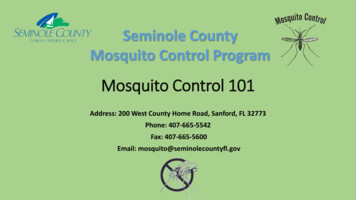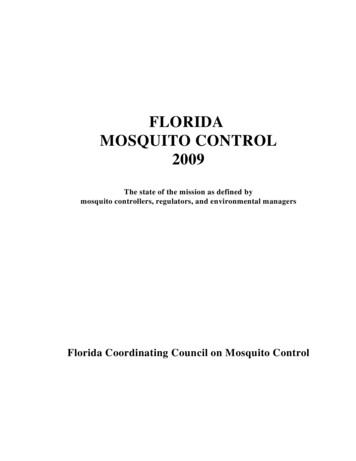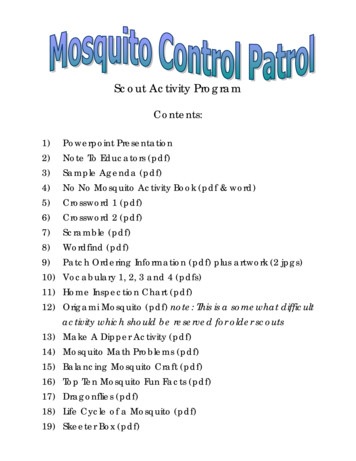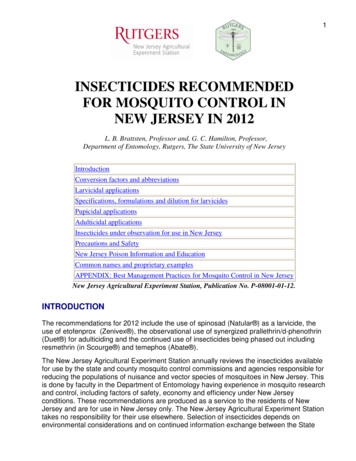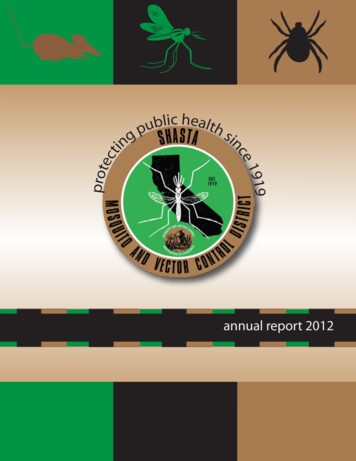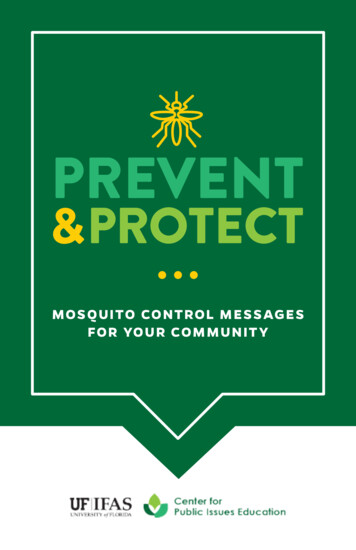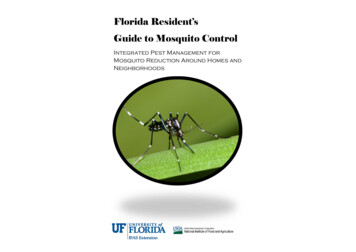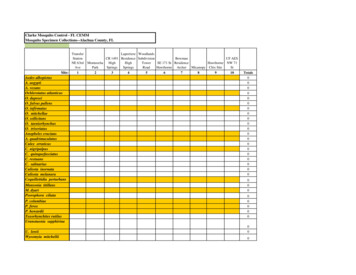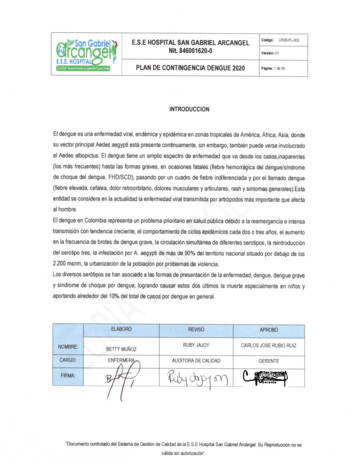
Transcription
Wyoming Commercial PesticideApplicator TrainingMosquito ControlCOMMERCIAL APPLICATOR CATEGORY911-0 "MOSQUITO CONTROL"University of WyomingCooperative Extension ServiceDepartment of Plant SciencesP.O. Box 3354Laramie, WY 82071Information in this publication obtained from the University of Floridaand the American Mosquito Control Association at the Public HealthPest Control WWW site at http://vector.ifas.ufl.edu/.
Table of ContentsI. DEVELOPMENTAL STAGES . :. 1Immature Stages . 1Adult Mosquitoes . 2II. BIONOMICS AND HABITAT . 2Standing Water Mosquitoes . 3Floodwater Mosquitoes . 5III. MOSQUITO SAMPLING AND SURVEILLANCE . 6Mosquito Egg Surveys . . 7Larval and Pupal Surveillance . 8Adult Surveillance . 9Using Mosquito Survey Data . 12Arbo virus Surveillance in Vertebrate Hosts . 13Vertebrate Host Collection. . 14Blood Collection . 15Arbovirus Surveillance in Mosquitoes . 15IV. CONTROL . . 16Source Reduction . 17Larvicides. 18Adulticides . 19Biological Control . 20· Personal Protection . 21\
Public-Health Pest ControlPublic-Health Pesticide Applicator Training ManualMOSQUITOESMosquitoes are in the family Culicidae of the order Diptera and are similar in appearanceto other flies. However, ill many important characteristics the anophelines (Anophelesspp. only) differ from the culicines (all other mosquito genera occurring in the U.S., seeTable 3.1 ). Mosquitoes pass through four distinct stages in their life cycle: egg, larva,pupa and adult. Prodigious numbers of mosquitoes can hatch simultaneously under theproper conditions. In rapidly developing broods, survival of the immature stages can bequite high, but estimates for many species indicate that immature survival is normallyless than 5 percent. But 5 percent of millions represents a sizable number. Irrespective ofpopulation densities, if they transmit disease or preferentially feed on humans, whichmany species do, they become appropriate targets for control activities. This chapterdeals with the bionomics of mosquitoes and reviews surveillance practices and approvedcontrol methods.I. DEVELOPMENTAL STAGESImmature StagesEggs . Mosquito eggs are white in color when first depositedbut darken within 12 to 24 hours. Most species' eggs appearsimilar when seen by the naked eye, with tre exception of theAnopheles spp., whose eggs have floats attached to each side.When viewed with magnification, eggs of different species canbe seen to vary from canoe-shaped to elongate or elongate-ovalSingle egg and egg raftin shape. Some species lay eggs singly, and others glue themtogether to form rafts. The incubation period (elapsed time between oviposition andreadiness to hatch) is dependent on environmental and genetic factors and variesconsiderably among different species.Permanent water and standing water species deposit their eggs directly on the watersurface, and these may hatch in one to four days depending on temperature. Manyfloodwater and container-breeding species deposit their eggs on moist soil or other wetsubstrates. These eggs may hatch within a few days after being flooded, or the fullydeveloped larvae may remain within the eggs for up to a year or more depending onimmersion conditions. These quiescent eggs accumulate over time due to continuedoviposition by blood-fed females. When temporarily flooded, they hatch, along withmore recently deposited eggs. Populations can attain largenumbers quickly this way.Larvae. Larvae (wigglers or wrigglers) of all mosquitoes live inthe water. Near the last abdominal segment in most species is aNonanopheline larva
siphon or air tube that serves as a respiratory apparatus when the larva suspendsvertically below the water surface. Larvae of Anopheles, however, breathe through acluster of small abdominal plates, which causes them to lie flat close to the underside ofthe water surface when not diving. Larvae of some species are predaceous (e.g.,Toxorhynchites rutilis and Psorophora ciliata) and prey on other invertebrates, includingmosquito larvae. Most larvae are filter feeders, ingesting anything smaller than about I 0microns by vibrating their mouth brushes and sweeping in particulate matter and smallorganisms from the surrounding water. Depending on the species an environmentalconditions, mosquitoes may take anywhere from,. three to four days up to several weeks to completelarval development. Mature 4th instar larvae moltto the pupal stage.Larva of Anopheles spp.Pupae. Unlike most other insects, mosquito pupae can be very active and areoften called "tumblers" because of their rapid, tumbling-like movement whendisturbed. Mosquito pupae breathe through two respiratory "horns" when atthe water's surface, do not feed and typically transform into adults in two ormore days.Adult MosquitoesAdult mosquitoes are terrestrial and capable offlight. With piercing-sucking mouthparts, thefemales feed mostly on animal blood and plantnectar. Males' antennae have dense bristles, andtheir mouthparts are modified to suck nectar andplant secretions, where no piercing is required.The adults of some species remain within a fewhundred feet of where they spen the larvalstage, whereas others may migrate up to 50miles or more. Eggs develop a few days afterfemales take a blood meal. Females oviposit onthe water, in crevices in the soil, or on otherAsian Tiger Mosquitofavored substrates or special niches that are orwill subsequently be flooded, such as naturaland artificial containers or tree holes, and the cycle repeats itself. Females of somefloodwater species may live up to a month after they emerge, whereas those of somepermanent water or standing water species can survive for several months byoverwintering as mated, engorged adults. Some species, including those whose eggsrequire freezing temperatures, are limited to a single generation per year, whereas othershave multiple nerations.II. BIONOMICS AND HABITATThose casually acquainted with mosquitoes may believe that all types are much the same,and, indeed, the similarities between species is considerable. There are, however, many2Pupa
differences in appearance from species to species and even among some varieties withinspecies. These morphological differences, especially notable in the larval and adultstages, permit accurate identification of most species. Behavioral differences permitvarious species to occupy numerous ecological niches with relatively little overlap. Thus,knowledge of the source or breeding habitat of mosquitoes can provide strong clues totheir identification.Mosquito control requires knowledge of the behavioral and habitat differences amongspecies in order to plan and carry out a treatment program. The trained worker firstidentifies the problem species. With identity established, useful correlations areimmediately available, such as the type of breeding habitat and where to search forlarvae. A working knowledge of the behavior and habitats frequented by various speciesaids in determining the kinds of survey and control strategies best suited for the task.Mosquitoes are not adapted to life in moving waters, but they can occupy the quiet poolsand seepage areas near flowing streams. Aquatic environments differ chiefly in thechemistry of the water (acid or alkaline; fresh, salt or brackish). These environments maybe natural or man- made and may also differ in the amount or type of vegetation presentand the amount of sun or shade. Coquillettidia perturbans, Mansonia dyari and Ma.titillans, for example, are found in association with specific aquatic plants - waterlettuce, water hyacinth and cattails. Wyeomyia spp. are found in association withbromeliads and pitcher plants. In this regard, the distinctive egg-laying habit of eachspecies of mosquito determines its larval habitat. Although some species use more thanone type of habitat, most mosquitoes can be categorized in general terms by theirpreference for either permanent water, floodwater, transient water or artificial containerand tree-hole habitats. These categories can be combined into two major larval habitatcategories: standing water (permanett and transient) and floodwater (including naturaland artificial containers as well as floodwater).Standing water species deposit their eggs (either singly or in rafts) on the surface ofpermanent or transient pools of standing water. They usually produ::e several generations(broods) each year and overwinter or survive harsh environmental circumstances asmated, engorged females. In contrast, floodwater species deposit their eggs out of thewater but in locations subject to periodic flooding, such as darr:p soil in depressions orinside tree holes, crab holes and artificial containers. They produce one to several broodsannually and overwinter or survive harsh environmental circumstances in the egg stage.Mosquitoes are adaptable to changing environmental conditions and are thus associatedwith multiple habitat types.Standing Water MosquitoesPermanent water group. Mosquito groups assigned to the permanent water group areAnopheles spp., Cu/ex (Melanconium) spp., Cx. salinarius, Cx. territans, Coquillettidiaspp. and Mansonia spp. As examples, the following permanent water habitat types andresident species of Florida are more or less typical of those found throughout the nation3
Freshwater marsh: Mosquito species often found in freshwater marshes include An.walkeri, An. crucians, Psorophora columbiae, Cx. nigripalpus, Cx. salinatius, Cx.tarsalis, Cx. erraticus and Cx. peccator.Lakes: Larvae may be found when many species of floating or emergent plants arepresent, but where vegetation occurs only in a narrow band along the Iakeshore, larvaeare confined to this littoral zone. Lake species include An. crucians, An. quadrimaculatusspp. complex, An. walkeri, Uranotaenia sappharina, Ur. lowii, Cx. salinarius, Cx.nigripalpus, Cx. erraticus, Cx. peccator, Cq. perturbans, Ma. dyari and Ma. titillans.Ponds and seepage areas: There is no clear distinction between a pond and a lake exceptthat ponds are generally smaller. Grassy woodland ponds or fluctuating ponds occupyshallow depressions and are filled by rainwater or surface run-off. They are usually ofuniform depth, but the area they cover will vary, depending on rainfall. Sinkhole pondsare usually quite deep and may be covered with vegetation or free of all except marginalplants. Both types of ponds may contain larvae of An. crucians, An. quadrimaculatus spp.complex, Culiseta inornata, Cs. melanura, Cx. nigripalpus, Cx. quinquefasciatus, Cx.restuans, Cx. salinarius, Cx. erraticus, Cx. peccator, Cx. pilosus, Cx. territans andOchlerotatus canadensis.The seepage areas around hillsides and ponds or streams most often breed An.punctipennis, An. quadrimaculatus spp. complex, Oc. stictlcus and Ps. ferox.Springs : Mosquito breeding in springs is restricted to the quiet edges where vegetationaffords cover for the larvae and there is little, if any, water movement. The only speciesrecorded from this habitat in Florida are An. quadrimaculatus spp. complex and An.perplexens.Swamps: Swamps differ from marshes principally in having dense cover from largertrees. The most common species of mosquito larvae found here are An. crucians, An.quadrimaculatus spp. complex, Cs. melanura, Oc. canadensis, Mansonia spp. and Cq.perturbans.Transient water group. Mosquito groups assigned nationally to the transient watergroup are Cx. quinquefasciatus, Cx. tarsalis, Cx. restuans, Cs. inornata and Cs.melanura. As examples, the following specific habitat types and resident speciesdescribed in Florida are more or less typical of those found throughout the nation.Salt or brackish water ditches: The ditches adjacent to saltwater marshes contain manyspecies of grasses and support a large mosquito fauna, including Oc. taeniorhynchus, Oc.sollicitans and An. bradleyi.Borrow pits and canals: These man- made bodies of open water produce moremosquitoes as they silt-in and become overgrown with vegetation. They yield An.quadrimaculatus spp. complex, Cs. inornata, Ps. columbiae, Oc. canadensis, Cx.nigripalpus, Cx. quinquefasciatus, Cx. restuans, Cx. salinarius, An. albimanus, Cq.perturbans and Mansonia spp.4
Freshwater drainage ditches: In pastures, at the bottom of road shoulders, in oldfields and in lowland groves, freshwater ditches will often yield the following species ofmosquito larvae: Ps. columbiae, Cx. nigripalpus, Cx. pilosus, Cx. erraticus, Cx.quinquefasciatus, An. crucians, An. walkeri, Oc. atlanticus, U. sappharina, U lowii, Ps.ciliata and Oc. sollicitans.Floodwater MosquitoesFloodwater group. Mosquito groups assigned nationally to this floodwater group are Oc.sollicitans, Oc. taeniorhynchus, Oc. tormentorlatlanticus, Oc. thelcter, Oc. dorsalis, Oc.nigromaculis, Ae. vexans, Ps.ferox and Ps. columbiae. As examples, the followingspecific habitat types and resident species described in Florida are more or less typical ofthose found throughout the nation.Mangrove swamp : In the transitional zone from normal high tide to above all but thehighest spring and storm tides, the heaviest mosquito breeding occurs. Plant and grasscover keep moisture conditions suitable for egg laying. Eggs are usually laid on slopingsides of potholes, ditches, sloughs, marsh edges or on the sides of small depre.ssions, andsometimes over extensive, level, grass-covered areas. The eggs of some species requirealternate flooding and drying before hatching. Species most often occurring are Oc.taeniorhynchus, Oc. sollicitans, An. atropos and Cx. nigripalpus.Salt marsh: Salt-tolerant rerbaceous plants and typical salt grasses dominate this type ofhabitat. Extensive areas are often covered by a single plant species such as Distichlisspicata, Batis maritima or Salicornia perennis. It is in association with one of theseplants or with black mangrove (Avicennia germinans) that breeding of Oc.taeniorhynchus and Oc. sollicitans occurs.Rain and floodwater pools: These pools form the breeding place for a large number ofspecies, especially Psorophora, Aedes and Ochlerotatus. The pools disappear in dryweather and support no true aquatic vegetation, though usually a layer of leaves and otherdetritus settles on the bottom. Mosquito species found in this habitat are Ps. johnstonii,Ps. pygnaea, Oc. atlanticus, Oc. bahamensis, Oc. dupreei, Oc.fulvus pa/lens, Oc.infirmatus, Oc. mitchellae, Oc. sticticus, .Oc. tormentor, Ae. vexans, Ae. cinereus, Cx,atratus, Cx. pilosus and Cx. nigripalpus.Artificial container and tree-hole group. Mosquito groups assigned nationally to theartificial container and tree-hole group are Ae. aegypti, Oc. triseriatus, Oc. sierrensis, Ae.albopictus, Cx. quinquefasciatus, Toxorhynchites spp. and Orthopodomyia spp. Asexamples, the following specific habitat types and resident species described in Floridaare more or less typical of those found throughout the nation.Tree holes: Tree holes or rot cavities support a rather extensive and unusual mosquitofauna, with many species breeding almost exclusively in this habitat: Resident species areAn. barberi, Tx. rutilis rutilis, Tx. r. septentrionalis, Oc. triseriatus, Oc. hendersoni, Or.signifera, Or. alba, Oc. thibaulti andAe. albopictus.5
Crab holes : Along the eastern coast the holes of the large land crab, Cardisonzaguanhumi, serve as the larval habitat for Deinocerites cancer and Cx. opisthopus.Artificial containers: Several species breed in human-created situations around humandwellings. Tin cans, fish pools, cisterns, rain barrels, gutters and old tires, etc., containingwater serve as excellent larval habitat. Species most often encountered are Ae. aegypti,Oc. triseriatus, Cx. quinquefasciatus, Cx. restuans, Cx. salinarius, Cx. nigripalpus andAe. albopictus.That many species are found in multiple habitat types and some in very specializedhabitats illustrates the complexity of the problem faced by control agencies. While habitatassociation with many species is quite specific, others thrive in a variety of situations.Thus, the detection of adults of these latter species in routine surveys does not provide animmediate indication of the related breeding site(s).III. MOSQUITO SAMPLING AND SURVEILLANCESurveys are essential for the planning, operation and evaluation of an effective mosquitocontrol program, whether for the prevention of mosquito-borne diseases or to reducemosquito populations to levels permitting normal activities without undue discomfort.Initial surveys identify the species of mosquitoes present and provide general informationon locations, densities and disease potential. With this knowledge it may be possible todetermine life cycles and feeding preferences; predict larval habitats, adult resting placesand flight ranges; and perhaps even make preliminary recommendations for controlprograms.The next step is to embark on a formal surveillance program in which routine monitoringof mosquito presence is conducted. A basic inspection program usually addresses adultand larval population density and species composition, rainfall and tide monitoring, andbreeding site locations. Additional specialized surveillance may be conducted to detectarboviral presence in birds and mosquito populations, operation of ovitraps (e.g., for Ae.aegypti and Ae. albopictus surveillance), or sampling of floodwater mosquito eggs tolocate breeding sites. This information not only provides justification for source reductionand insecticide applications, but it also serves as an ongoing indicator of the effectivenessof these activities and continually adds to the database of knowledge concerningmosquitoes in the area. Such inspections do not determine the absolute population ofmosquitoes, but they can show fluctuations in relative mosquito abundance and diversityover time in the various habitats visited.Mapping. Reasonably accurate and comprehensive maps are essential in conducting amosquito-control operation. Maps provide information for field survey and controlactivities, program evaluation, and reporting and budgeting purposes. They showelevations, streets, roads and railroads, as w ll as ponds, lakes, streams, sewage lagoons,flooded woodlots and other breeding areas. They are used for orientation and for locatingand plotting larval breeding places and adult sampling stations.6
When lar areas are involved, a master map may be needed for planning drainage andother field operations. The master map will indicate the treatment areas, the possibleflight range of mosquitoes from breeding sites and the potential degree of penetration intopopulated areas. Larval and adult sampling stations can be indicated by symbols andnumbers. Counts made at these stations at weekly or biweekly intervals provideinformation for current evaluation of the mosquito problem at any time by indicating theabundance of mosquitoes, species involved, flight range and habitat, and diseasepotential. This information identifies areas requiring high priority for treatment.Narrative descriptions, sometimes necessary for exact location description, are simplifiedwhenever possible. For example, "N.W. corner of 15th Street and Ninth Avenue" is abrief description that leaves no doubt as to the location. There may be some areas that aredifficult to accurately locate (e.g., marshlands). However, maps can be subdivided intonumbered or named areas for easy reference, and Global Positioning System (GPS)coordinates are very reliable. Some common methods of subdividing maps involve theuse of geographical features, artificial grids or a combination of both to set boundaries onareas that are indexed for easy reference and filing. To avoid cluttering, the larger areasmay be further subdivided by the use of transparent overlays, again employinggeographical features or a grid. Once the area of inspection is delineated by reference toindex numbers, additional location data can be conveyed clearly by the use of cards thatinclude a rough sketch of the area or incorporated into a Geographic Information System(GIS) foimat.Record keeping. In order to avoid comparing dissimilar parameters, inspections shouldbe consistent both in method and location. Keeping clear, accurate records is as importantas the data gathering itself. Surveillance records are managed in a manner that ensuressubsequent inspections can be conducted in a similar manner by others less familiar withthe area. They usually include the inspector's name, date of inspection and exact locationin addition to the data collected.Data-recording forms and devices promote uniformity, which makes records easier toread, interpret and summarize, and serve as a reminder to the inspector to record allpertinent information. In the absence of data recorders, standardized formats lead to moreconsistently accurate transcription of the data into the permanent records.Mosquito Egg SurveysEgg surveys are carried out primarily to determine the exact breeding locations ofmosquitoes. Aedes, Ochlerotatus and Psorophora mosquitoes lay their eggs on damp soilin places subject to intermittent flooding. Two types of egg surveys may be conducted forthese genera: sod sampling and egg separation.Sod sampling. Sod samples, usually containing 8 cubic inches of soil and vegetationwith a thickness of about an inch, are stored for a week or more to allow the embryostime to develop within the eggs. The sod samples are then placed in glass jars andflooded with water. The larvae are identified after they hatch. Several sequentialfloodings and dryings inight be necessary to get sufficient cumulative hatch. In larval7
surveys, sod sampling delineates breeding areas, especially when sampling is done duringtimes when larvae are not present.Egg separation Egg separation machines can be used for '1:: '!separating mosquito eggs from soil and debris bymechanical agitation, washing, screening, orsedimentation of debris and flotation of the eggs in asaturated salt solution. Sod or soil samples are cut in thefield with a sharp trowel around a 6-inch-square template,placed in plastic bags and stored (sometimes for months)in a cool room. The various species and densities ofAedes, Ochlerotatus and Psorophora can be identified bymicroscopic examination of live or preserved eggs usingEgg separation nrn binetaxonomic keys for mosquito eggs.Oviposition trap. Collections of mosquito eggs in oviposition traps are used to detectand monitor container-breeding mosquitoes such as Oc. triseriatus, Ae. aegypti and Ae.albopictus. The oviposition trap can easily be made out of food cans (3-pound coffeecans) or pint jars painted black inside and outside. The traps are placed in shaded areas ata height no greater than 1.2 m and filled with water and a few dried leaves placed at thebottom of the container. An oviposition substrate made of a strip of various materials(seed germination paper, muslin, formica, balsa wood, wooden tongue depressor, etc.) isthen placed vertically inside the container with the water covering about half of it.Gravid females use this substrate to lay eggs just above the water level. Traps areASP AATOA F011001.u :T1t.1G -'OV'-TSchecked every 10 to 14 days to preventthem from becoming breeding sources. Iflarvae are found in the trap then the watershould be dumped and the trap reset. Theovipositional substrate is periodicallycollected and returned to the laboratory ina plastic bag. Samples are kept cool andmoist during transportation, taking care toavoid too much moisture, which couldcause eggs to begin hatching. Eggs or theresulting 4th instar larvae are thenidentified., . .,,. ---.Larval and Pupal Surveillance(tmlr-.:- -Before beginning a survey, obtaininformation about the general breedingbehavior and habitats of the species knownor suspected to be in the area. Anexperienced person may be able to spot theprobable mosquito breeding places in aspecific area by rapid reconnaissance.These areas are carefully numbered andmarked on the map. Determining the tU. 10X ·8f'Oft A.OUl.1'SflutMPl aoo11
specific breeding sites and establishing permanent larval sampling stations requires amore detailed inspection. Larval surveys to determine the exact areas in which themosquitoes breed and their relative abundance are of special value in control operations.Equipment. A white enameled or plastic dipper about 4 inches in diameter (1 pint or 350ml capacity) is frequently used for collecting mosquito larvae. The handle of the dippermay be lengthened by inserting a suitable piece of wood dowel or PVC pipe. Speciallydesigned dippers can be created so that their capacity can be directly related to theamount of water surface examined. Thus, the number of larvae per square foot or metercan be computed with reasonable accuracy.Dip procedure. Mosquito larvae of some species are usually found near surfacevegetation or debris. In larger ponds or bodies of water, these larvae are ordinarilyconfined to the shoreline areas where it is necessary to proceed slowly and carefully insearching for mosquito larvae as disturbance of the water or shadows may cause thelarvae to dive to the bottom. Anopheline larvae are collected by a skimming movementof the dipper with one side pressed just below the surface. The stroke is ended just beforethe dipper is full because larvae will be lost if the dipper is filled to the point that it runsover. Where clumps of erect vegetation are present, it is best to press the dipper into aclump with one edge depressed so that the water flows from the vegetation into thedipper. Culicine larvae such as Ae. vexans or Oc. sollicitans or species of Psorophorarequire a quicker chopping motion of the dipper as they are more likely to dive below thesurface when disturbed.The inspector records the number of dips made and the number of larvae found, by instarif warranted, and transfers representative sample specimens by pipette into small vials ofalcohol for later identification. With m:: st species, it is possible to get a rough idea of thebreeding activity by computing the average number of larvae of each species per dip. Thenumber of dips required will depend on the size of the area and the relative larval density,but for convenience is often in multiples of 10. Inspection should be made at weekly orbiweekly intervals during the mosquito breeding season, s areas that are entirelynegative at one time may rapidly become heavily infested.Inspections for certain species require variations in the procedure described above. Forexample, Coquillettidia larvae remain below the surface throughout much of theirdevelopment attached by the siphon to the stems of emergent vegetation. These larvaeare found by pulling up aquatic plants (cattail, sedges, pickerelweed, etc.), washing orshaking them in a pan of water, and searching the bottom muck and debris.Inspection for Oc. triseriatus, Oc. sierrensis, etc., breeding involves searching tree holesand artificial containers such as tires. These containers are often too small for an ordinarydipper, but water can be transferred with a turkey baster or siphoned into a dipper or panwhere the larvae can be seen.Adult SurveillanceAdult- mosquito surveillance permits evaluation of the incidence of mosquitoes withinresidential areas where they might bite people and shows the relative abundance of9
various species. Using this information and reference material in relation to breeding sitesand habits of the resident species, vector-control specialists can determine the need for acontrol program and conduct an effective search for larval hreeciing places. Interpretingthese observations also provides the justification for applying or withholding controlmeasures.Landing and biting collections. The required equipment for this method of adultmosquito survey is simple and inexpensive and consists of an ethyl-acetate-chargedcollecting tube or power aspirator, pill boxes, cages for live collections, field recordforms or notebook, pencil, flashlight and map. Although most districts use batteryoperated mechanical aspirators, a simple mouth-suction aspirator can be made from ase
Mosquito Control COMMERCIAL APPLICATOR CATEGORY 911-0 "MOSQUITO CONTROL" University of Wyoming Cooperative Extension Service Department of Plant Sciences P.O. Box 3354 Laramie, WY 82071 Information in this publication obtained from the University of Florida and the American Mosquito Control Association at the Public Health
